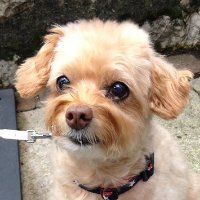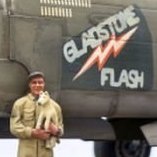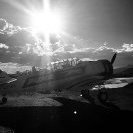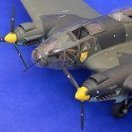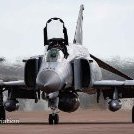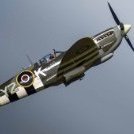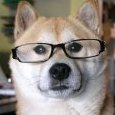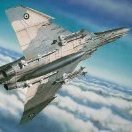Search the Community
Showing results for tags '1/32'.
-
Greetings all Here is my latest offering of a Ju87D-8(N) E8+HH that was operated by 1./NSGr.9 during the second quarter of 1944 near Florence, Italy. It was lost in action on 7th July 1944. The final camo pattern and colours are a bit of a departure from the kit call-outs, but the rationale behind the decisions because of actual photographic evidence can be found on the build article. 1/32 Hasegawa JU87D-8 kit Aires cockpit AIMS AB500 bomblet containers plus some flash hiders I poached from one of my AIMS Bf110 detail sets and an antenna isolator HGW seatbelts SB cannon barrels and pitot tube Quickboost Type A exhausts Quickboost Spinner and VDM blades Profimodeller detail set for airbrake hinges and underside bomb release Master Mg81Z barrels for the observer position Nice build overall, great having a big Stuka in the collection now!! Real bird is the 2nd aircraft of the image underneath...
- 27 replies
-
- junkers
- ju87d-8(n)
- (and 11 more)
-
This build has been in progress since March, but stalled for a while. It's my first large scale build since returning to the hobby and I went all in on the aftermarket. Cockpit is Quinta Studios, with a few pieces of Eduard PE, and HGW belts. Added Eduard PE flaps. I've read that RAF pilots were trained to retract flaps as soon as they left the runway so you wouldn't normally see them extended on the ground. We'll just pretend they're getting maintenance or something like that. The build was smooth overall except for the wing to fuselage fit. I think this was my fault, but not sure what I screwed up. The fillets were just a bit too narrow to seat in place on the fuselage and I had to do a good bit of sanding and scraping on the right side to make them fit. After priming I realized that the right fillet had collapsed a bit - I guess I took too much material in working on the fit. I didn't take pics of the damage, but the fillet was sitting a good 2-3 mm lower than the side of the fuselage. I used green stuff putty to fill in most the sunken area and Tamiya putty to fill in the top layer. It took about 4 rounds of sanding and priming to get the edges even and the shape reasonably correct. Finally yesterday and today I have been painting. All MRP paints - I marbled the top camo with RAF light earth and light green, then finished with dark earth & dark green. The camo was done freehand with the airbrush. I'm not unhappy with the result, but if I had it to do over I think I'd mask it. The bottom was marbled with white, and then the white side got some additional marbling with earth yellow before a top coat of white, and the black side got additional marbling with haze grey before a top coat of "black night". Going to put a gloss coat on tomorrow so the paint has some protection, then this weekend I will be trying out those 1ManArmy stencils.
-
Greetings all I've always enjoyed the Stuka since I was a kid, so had it in the back of my mind to build a night attack version using the Owl markings. Managed to get hold of a Hasegawa G-2 (with Mater barrels) that I was going to convert into in D-8, but then as luck would would have it, I found a D-8 on an auction that fit the bill perfectly. So.....I suppose I will eventually get to building the night G-2, but this D-8 comes first. So below is the version of the D-8 I was going to build, however, the kit markings and camo scheme are way more appealing to me. So there we go. I'll be building that specific version as on the box art. The G-2 version I'll do at a later stage with the Owl markings... As you can see from the above pics, I've the Aires interior set, Eduard masks and HGW belts for it. On the way is a Quickboost spinner and blade set, as well as a Yahu IP Cheers Iain
- 138 replies
-
Hello, everyone! Long time, no post. After completing the "panzer of the river" dio back in February, I've started a few things but struggled to get anything across the finish line. Happy (very) to report that this one is done. It fought me most of the way, but by the time I'd gotten really frustrated with it, I was too far along to pitch it. That said, I'm more or less happy with the result. The decals have me fits and you'll see quite a bit of silvering which is just super frustrating. I opted for decals as I wasn't confident that I would be able to get masks to lay down in the wing corrugations. Turns out the decals didn't feel like doing it either. Oh well. I was really geeked about the Devastator kit when it came out, but in my opinion, Trumpeter managed to put out an aggressively mediocre kit. In that regard, I guess Trumpeter managed to capture not only the form of the real airplane, but it's whole vibe too. So, kudos to them on that front, I guess. (?) Anyway, the fit was okay in general, but I had it in my head to really detail up the interior, only to find that it's really really spartan. The whole bomb aimer's area is just pure fantasy and doesn't line up with any of the reference photos in @Dana Bell's recent book. So, it made it a real challenge to want to try to do any extra detail work on the interior. I suppose in the end absolutely none of it would be seen anyway, especially with the wings folded, but I would have known. That said, I did use @airscale's PE and 3D printed products to add detail where I could. I can't recommend these highly enough and they're almost a requirement in my opinion. Off the top of my head, I used the interior set, the prop, wheels, gunsight, wing fold, and twin .30 mount. All fit pretty well without having to do much fiddling with adjacent parts and the added detail was/is lovely. Thanks @airscale! I ordered the ASK stencil set as the kit-provided stencils are ridiculous. However, I would also suggest that the ASK set is only slightly less ridiculous as they are rife with spelling errors and their instructions seemingly have you placing them randomly around the airplane. Weird. I used the Gold Medal decals for the aircraft markings and, fortunately, they came with stencils and much more plausible placement instructions. Any issues with them laying down on the model are mine, not theirs. Highly recommend the Gold Medal set. Also, if you don't have Dana's recent TBD reference book, just buy it. It's a fascinating walk through a really weird, esoteric, and utterly mid aircraft. I digress. This is my rendition of T-14, George Gay's aircraft from VT-8 on the day he became the sole survivor of his group's attack on the Japanese carrier fleet at Midway. If anyone's not familiar with it, here's a short primer on the whole thing. https://en.wikipedia.org/wiki/VT-8 Enjoy!
- 16 replies
-
- trumpeter
- devastator
-
(and 2 more)
Tagged with:
-
It all started innocently enough, for a Cold War airframe. Built in Blackpool in the winter of 1955, when the beaches were empty, but the Hawker Aircraft Blackpool (Ltd) factory was full. She was delivered to the RAF on 10 Jan 1956 as XF 309. Based on the only photographs I can find of her as a pristine F Mk.4, she went to 112 Squadron. You don't have to be an aviation anorak to work this bit out. A typical scene at a Hawker Aircraft factory: churning out Hunters in the mid 1950's 112 Squadron RAF was famous for being the first allied unit to feature a 'sharks mouth'. Even Chennault's 'Flying Tigers' copied them. This is a famous photo of 112 Sqn Tomahawks published in October 1941. No prizes for guessing which squadron XF 309 belongs to... This beautiful airframe was already withdrawn from service by December 1962, and used for ground instruction at St Athan as 7771 M. But don't worry, that's not nearly the end of this tale. While detailing and building the classic Revell kit, we will discover an amazing history in the life of a Hunter, that sees her dressing-up in Yorkshire and being blown-up in Zimbabwe. Let's get down to some plastic first. The kit needs no introduction, so I won't. What is interesting however, is how many of the Hunter builds on the internet stall for some reason or other - it clearly has some issues around the intake and the undercarriage. We'll tackle those when we get there. Not possessing (an increasingly rare) True Details aftermarket cockpit, there is going to be some extra work to get the rather basic cockpit looking a bit more like the real thing. I know its a typical Cold War dark pit, but some extra stuff is always nice. The only cockpit aftermarket I could find was the Kits World 3-D decals for the instrument panel and side consoles. I was most excited to try these, as it is a first for me, and they seem to have revolutionised cockpit detailing. Unfortunately, they didn't enjoy the trip to South Africa. I figured they would look good in the bin, but then thought I'd at least save one or two instrument faces. Some advice - if this happens to you - don't cut, don't throw it away, just treat them like normal decals. I eventually popped them in water and used a bit of white glue to stick them onto thin styrene. Maybe I can still use them? I have copied some ideas from Rockie Yarwood's 'Out of Africa' build, so thanks for pioneering the sidewalls Rockie! Here you can see the rather rudimentary way of using the kit part as a template for cutting ribs. And here the ribs are in situ. It is actually very easy to position them, as the kit is finely marked where the different cockpit components go. Modified the side consoles a bit, however much of the kit detail is useable as is. The stick and rudders really do need some help, as well as the mounting system for the rudder pedals - which would otherwise be pretty much flat on the floor. The gyro gunsight, it would seem, got the most attention! Looking a bit more like the jumbled office a Hunter's cockpit should resemble. Let's see if this one makes it to completion. Cheers, Sean
-
Hello everyone! It's been a veeeery long time since my last 1/32 project. But here I am, starting a new build—the Wingnut Wings 1/32 scale AMC DH.9. This will be my first WWI subject and will represent a Hellenic Naval Air Service aircraft that served during the Asia Minor Campaign. The specific aircraft, Spetsai—named after the Greek island of Spetses—was later specially painted for the victory celebration flyover of Constantinople. Work has begun with the cockpit, featuring the characteristic wooden structure typical of WWI designs. I airbrushed all components with a sand base coat, followed by a red brown layer applied through a wood grain stencil. The effect was unified using oil paints: applied, then gently wiped off with a soft sponge. I used raw umber for the frame and burnt umber for the sidewalls to replicate different wood types. The leather seat cushions were painted using a similar method. I first applied NATO black by brush, then added scratches using a mix of the base color lightened with sand. A final layer of burnt umber oil paint, partially removed, completed the leather effect. Smaller cockpit details such as instrument dials, pumps, levers, and push rods were brush painted with silver, grey, or brass. A black wash helped bring out depth and definition, and everything was sealed with a matt varnish. The engine firewall was painted in a white metal finish, with the upper section rendered in linen to simulate fabric. It was weathered with black oil paint to suggest oil streaks and splatter. The radiator and supplementary oil tank were painted light grey. For wear and chipping, I used a technique common in armor modeling: light grey chips applied randomly with a sponge, then painting the center with a darker grey to enhance contrast. Next step: cockpit assembly and engine installation. Thanks for following along!
- 36 replies
-
- wingnut wings
- amc dh.9
- (and 9 more)
-
Here is another of my latest builds. The base is Lukgraph's Potez 25, heavily moded with some home-designed and 3D-printed parts. It was built as part of the "Sandbox" GB on LSM, where you can find a more detailed build log. Before the pics, some background on this project. The idea was to build a project "that had something to do with use in the sand or desert". When doing some preliminray reserach, I stumbled upon some pictures which had an irresistible appeal for me . Let me explain why : 1. French colonial presence in North and Western Africa. In the the XIXth and XXeth Centuries, France expanded its colonial empire across large chunks of Africa, in the North, with Tunisia, Algeria and Morocco, and in the West and Center, expanding from the Ivory Coast and along the river Niger. In 1893, Ensign Aube, on an armed launch, went thus up the Niger river, until he reached Tumbuctu, with the goal of establishing a French presence there. After a few weeks, he was unfortunatley massacred with his expedition by the local tribes, which were subsequently defeated and submitted by a French ground brigade. The French presence in Africa went with the development of routes between the colonies, and thus the French had to tackle a major hurdle between the North and the West of Africa, i.e. the Sahara desert. This was was progressively mapped and crisscrossed with a number of roads, during the 1920s. A road was thus departing from Morocco, Tunisia or Algeria, to merge in Algeria in the North of Sahara, and then went south across the Tanezrouft and Sahara towards Mali and West Africa. Along this road, a number of stations were established, every 50 kilometers, initially by burrying a barrel of water ("bidon" is the French word for barrel), and developing limited infrasructures along these "Bidon" outposts, namely ways to refill the tanks of the trucks, coaches, cars ... and aircrafts which attempted to cross the Sahara. A famous post is "Bidon 5", in the Tanezrouft, which even had a "hotel" made of the bodies of two coaches. The "Black Cruise" ... and the Pink Cruise In 1933, France established the Air Force as a separate entity from the Army. To celebrate this event, a PR stunt was put in place : the "Black Cruise". The idea was to have a major force, made of about 30 aircrafts, that would fly from Paris to the Western African colonies, and back. Under the command of General Vuillemin, the Black Cruise was a huge success, and demonstrated the capacity of the newborn Armée de l'Air to project its force across the empire. This widely acclaimed feat warmed the inter-service rivalry between the Air Force and the Navy, which had its own aerial component, and more specifically the feelings of Rear-Admiral De Laborde, a consumate sailor AND aviator, who commanded the French Navy forces in Africa. De Laborde wanted to show that the French Navy was as able as the new Air Force, by replicating the Black Cruise. In December 1934, a commemorative plaque for Ensign Aube was to be unveiled in Tumbuctu. De Laborde informed the Ministry, that, as the most senior French Navy representative in Africa, he would personally attend the commemorative ceremony, with his wife. He only "forgot" the mention that he intended to reach Tumbuctu by aircraft, in a remake of the African leg of the Black Cruise. Thus, in November 1934, De Laborde, leading a flight of three aircrafts, with his wife as passenger, took off from Bizerte in Tunisia, to cross the Sahara and reach Tumbuctu. The flight was a success, and although a veil was put on it officially to avoid fostering the inter-service rivalty, the flight earned the somewhat derisive nickname or "Pink Cruise", to take into account the presence of Countess de Laborde, wife of Jean de Laborde. I found a period picture of the three aircafts, adorned with their "fishhook" roundels typical of the French Navy aircrafts, during a stop in the middle of the Sahara. The idea of a Navy aircraft about 3000 kms away from the nearest shore was just irresistible for me. And thus my GB entry was set ! 2. The Potez 25 The Potez 25 can, in many aspects; be considered the F-16 equivalent of the 20s and 30s. Built by Potez (who had been associated in WWI with Marcel Bloch to build propellers, before Bloch and Potez parted ways in the early 20s), using conventional WWI construction techniques, but with an innovative engine bearer structure that allowed almost and 500 hp engine to power it, it was produced at more than 3 500 units, and sold un used by 24 countries, not a bad number for these troubled peacetimes. It was thus sold to Poland, and it is because of this Polish Aviation link that we now have a 1/32 kit of the Potez 25, thanks to Lukgraph. The main variant of the Potez 25 was the A2, powered by the very successful and reliable Lorraine W12 engine, and this was the one used by the Polish Air Force and therefore represented by Likgraph. Bu the French developed a specific version for the Potez 25, the "TOE" (for Theâtre d'Opérations Extérieures", aka foreign opertions theater). Compared to the A2, the TOA had many differences, starting by a heavier weight dur to an enlarged main tank (which was jettisonable in flight in case of fire), and an additional fuel tank of 300 liters, conforming to the belly of the Potez. The extra CFT and larger main tank implied a revised nose cowling, to fair into the deeper belly, and a fariring of the under-rear fuselage, up to the tail. The TOE had also a larger radiator, to cope for the wemer climates it was supposed to operate into. This was achieved by adding "ears" to the radiator, fairing in the covers of the lower cylinder banks of the Lorraine W12 engine. To cope for the heavier weight, a new oleo undercarriage was developed by Messier, as well as a new tail skid. The Potez TOEs of both the Black and Pink Cruise also had two extra water tanks that prolonged the fairings of the lower cylinder banks. De Laborde's aircraft, coded "BZ 65) (BZ stand for Bizerte, the main base of the French Navy aircrafts in North Africa), also had a revised upper fairing above the cockpit, with the suppression of the rear gun position, a new windscreen for this position, a head-rest fairing for the rear position. It also had a seat comparable to the pilot's one in the rear position, as opposed to the initial bench-type for the rear gunner, and a set of radio emitters and receivers, identical to the ones used during the Black Cruise. 3. Building and converting Lukgraphs' Potez 25 The Lukgraph kit ias a sound, if not perfect, basis for a Potez 25 A2. To represent a TOE, I had however to proceed to some major surgery and changes. I designed the conversion parts, and 3d-printed them. The list of new parts include: - a new radiator, - new fairings for the clyinder banks, including the extra water tanks - a new lower nose / cowling - an extension of the mainfuel tank - a new underbelly conformal fuel tank - a hew fairing for the rear fuselage - a new main undercarriage - a new tail skid - a second seat for the rear position - new wheels as the TOE ones wear of bigger diameter and larger thread than the A2 ones. The standard practice for aircrafts crossing the Sahara was to have a third, spare, wheel fastened to the side of the fuselage. - radios for the emitters and transmitter (3 sets overall) - a new upper fuselage fariring over the cockpit. This Included the head-rest fairing. - a new windscreen for both the pilot and the rear passenger. In the end, i designed the whole new upper fuselage with the windscreens, and then printed it in clear resin. - new throttle quadrants and throttles, as the supplied PE parts were too flimsy … The kit is a typical high-quality resin kit, with some 3D-printed parts. It has, however, a significant issue, namely the - large - main upper wing is molded solid. When assembled, the upper wing alone weighs 186 grams. And the finished aircraft with all the additions is close to 370 grams. One of my pet topics is trying to replicate the "mass feeling" of the original subject in kit form. In theory, using the same materials, we would have a similar density. Thus, if the all-up weight of the Potez 25 was 2500 kilograms, the 1/32 kit shoudl weigh 2500*1000/32^3 = 76 grams. The finished kit is almost five times more heavy than it should be if the density was constant ! This creates issues of their own : a) large resin wings are known to sag and flex over time, b) the 3d-printed resin undercarriage may not be strong enough to withstand durably the weight of the finished kit, c) the supplied interwings struts and cabane struts, in 3d-printed resin, may just as well be unable to withstand the weight of the upper wing in the long run, as they have holes for just stub inserts of rods, but are not designed to have the reinforcind rods going through them. So I modified the lower sesquiplane wings to incorporate a span-continuous double spar made of 2 mm aluminium tubing. The spars are connected to a reinforced carry-through structure in the fuselage. New struts were designed and printed that allowed to insert 1mm-dia steel rods across their wole length. The undercarriage was similarly designed to allow the introduction of brass rods reinforcements, and to be connected to the internal carry-trhough structure. By the way, the 3d-printed tail skid did not resist the weight and snapped after about a week. I replaced it with a new one sratchbuilt out of brass. The upper wing is made of three parts (a central and two outer wings panels). They were drilled to a significant depth to allow to insert 2mm-tube spars. And the rod-reinforced interwing struts and cabane struts all connect to the carry-through structure inside the fuselage or the lower sequiplane spars. The Potez 25 TOE was the workhorse mainstay used both for the Black Cruise and, as a utility aircraft, by the French Navy, and therefore for the « Pink Cruise ». De Laborde's Potez, coded BZ65, sported the 4-star pennant of a rear-admiral on its fin. This made BZ65 a true "Blue Goose" aircraft. The markings are a mix of masks, home-made decals and the kits decals (the "fishhooks" come from the Lukgraph decal sheet. All the rest is either masked or home-dessigned and printed. 4. The saynette I found many pictures of the various Sahara stops performed by French aircrafts. Whilst the major "Bidon" stops had fuel pumps, for both the wheeled vehicles and the aircrafts, in other places, the fuel drums were brought in by 4-legged bowsers, namely camels ! I had my scene : BZ65, the Potez of de Laborde and his wife, stopped in the Sahara, whilst camels bring in the fuel drums to replenish the aircraft. I found that the drums in these occasions used were not the "standard" 200 or 225 liters drums, but smaller, more handleable ones of 70 liters. A net search provided the specs of these 70-liters drums, which I also designed and printed. The ubiquitous "Japy" hand-pump was used for refueling. One was designed, printed and inserted in its location in the lower fuselage, where it cannot, unfortunately, be seen ... The 1/32 camels are 3d-printed, found on a German website. The figures, including Mrs de Laborde and his husband, are from various sources, like Red Dog or The Bodi Capsata, or others. Finally, a picture showed that these airbases in the Sahara had a windsock. One was designed and printed in clear resin. Duly painted, the see-through effect of the fabric windsocks was restituted pretty convincingly And now, after this lengthy intro, on to the pics. You can click on them to get enlarged versions. At the end are some detailed pics of the WiP process. I hope you like it. Hubert PS: the scene also had an « interesting » ingredient to it : part of the « sand » is actually some curry powder I had mixed up to the « right » colour on the Marrakech souk. The odour is now faded out, but my work area smelled very good for a few months 😂 …
- 24 replies
-
I don't usually do WIPs, but decided for some reason that I'd make the effort with this one, as it's an unusual subject, not least that it's a helicopter in a proper aviation scale. I bought the Revell kit at a show last year for a good price. The kit is in Revell's new box and style, and it was only later I discovered that it was first issued in 1996. This is not a problem, it will just need some work. The box has some colourful options, but I settled on going off-piste and doing a British one. The Army Air Corps bought 16 or thereabouts in the late 1950s/early 1960s to fill a capability gap until the Westland Scout was available. I'll be doing XR385 (c/n 1645) as it appeared at the Middle Wallop Army Air Day in 1975. So on with the show. First the box, illustrating how I deal with those end-opening boxes: cut the top out and tape up the ends. It's a simple kit. Three grey sprues, one clear sprue, instructions, decals, and safety info slip At the moment I can't find any aftermarket for it, any suggestions welcome. (Edit: just found some Eduard Etch - we'll see.) I'll add a set of generic seat belts and some home-cut masks for the markings, otherwise it's from the box all the way. Back later with (hopefully) some actual work accomplished.
- 32 replies
-
Hello to all! I want to present on Your review information about the LSP products of the Metallic Details. Perhaps some of You will be interested in this. https://metallicdetails.com/ Detailing set for aircraft model F-35A (Italeri, 1/32) Jet nozzle for aircraft model F-35A (Italeri, 1/32) F-35A. Ejection seat (1/32) F-35. Seat belts (1/32) AH-64 Apache. Longbow radar (Academy, 1/35) Mi-24/Mi-35. Wheels set (1/35) B-24. Wheel bays (HobbyBoss, 1/32) B-24. Exterior (HobbyBoss, 1/32) B-24. Turbochargers (HobbyBoss, 1/32) Pratt & Whitney R-1830 (HobbyBoss, 1/32) Control handles. Part 2 for German aircraft models (1/32) FuG 218 Radar (1/32) Revi 16B Gunsight (1/32) Static dischargers (1/32) Tail support for Bf 109E (1/32) Tail support for Bf 109F, G (1/32) M18 gun pod with M134 Minigun (1/32) M65 rocket launcher (1/32) XM157 2.75 inch rocket launcher (1/32) XM158 2.75 inch rocket launcher (1/32) XM159 2.75 inch rocket launcher (1/32) Emerson Electric TAT-102 Turret for AH-1G Cobra (ICM, 1/32) Emerson Electric M28 Turret for AH-1G Cobra (ICM, 1/32) USAF seat belts part 1 (1/32) Bell AH-1G Cobra. Masks (ICM, 1/32) Bell AH-1G Cobra. Interior (ICM, 1/32) Bell AH-1G Cobra. Exterior (ICM, 1/32) M197 Gatling gun (ICM, 1/32) Yak-9. Landing gears (ICM, 1/32) Yak-9. Exhausts (ICM, 1/32) Gloster Gladiator. Cowling and engine (ICM, 1/32) Gloster Gladiator. Wheels (ICM, 1/32) Fiat CR.42 Falco Cowling and engine (ICM, 1/32) Fiat CR.42 Falco Propeller set (ICM, 1/32) Fiat A.74 (1/32) Arado Ar 196 Cowling and engine (1/32) Arado Ar 196 Propeller set (1/32) Pratt and Whitney R-2800 (1/32) Gnome-Rhone 14M (1/32) Gnome-Rhone 14K (1/32) Gnome-Rhone 14N (1/32) Bristol Taurus (1/32) Pratt & Whitney R-2800 late (1/32) Bristol Mercury (1/32) Ejection seat KK-1 (1/32) Ejection seat KK-2 (1/32) ASP-3N sight for MiG-15, MiG-17, La-15 (1/32) Ejection seat KM-1M (1/32) Ejection seat F16F Rafale (1/32) Spitfire Seat (1/32) Hurricane Seat (1/32) A-26 Invader Seats (1/32) B-26 Marauder Seats (1/32) Harrier GR.3, GR.7, GR.9 Ejection seat (1/32) Spitfire Mk.I-Mk.IX seat belts (1/32) RAF Hurricane seat belts (1/32) Mk.7 Ejection seat seat belts (1/32) USAF seat belts WWII (1/32) Japan seat belts WWII type 1 (1/32) Japan seat belts WWII type 2 (1/32) Japan seat belts WWII type 3 (1/32) Japan seat belts WWII type 4 (1/32) USSR seat belts WWII (1/32) MiG-21, MiG-23, MiG-25 seat belts (1/32) MiG-15/MiG-17. Seat belts (1/32) Mi-24 Seat belts (1/32) Martin-Baker Mk.10 Seat belts (1/32) Blackburn Buccaneer. Seat belts (1/32) Italian Seat belts WWII (1/32) Harrier GR.3, GR.7, GR.9 Seat belts (1/32) Thank You for Your attention!
- 92 replies
-
- italeri
- aftermarket
-
(and 6 more)
Tagged with:
-
Good morning all, I know I have another topic on the cooker right now (the Travel Air Mystery Ship), but as for the time being I have definitely stopped working on LSM's kit, and my correction work is more virtual modelling than anything else - but that will not last -, my longing for actually fondling some plastic (or resin for that matter) was definitely too strong. Time to start another one then ! Back in 1965 (or was it 1966 ?) my father was an officer in a tank regiment based in Kaiserslautern in Germany. We used to travel to my birthplace (Saumur, house of the Ecole de Cavalerie, and of a beautiful tanks museum - I remember playing inside a T-34 or a Sherman, but this is another story - for Christmas. On the way back home, at night, I saw a beautiful glistening ball on the banks of the Loire river: this was the dome housing the Chinon nuclear plant, a graphite-gas plant. I was hooked from then on with anything scientific and engineering. For that specific Christmas, I got a wonderful present : a book on aviation. This one hooked me forever on aeronautics. It was full of incredible shapes, and among these science-fiction pictures, were two which I still remember vividly, and which have set my unconditional love for those two beautiful airframes : the B-58 Hustler, and the Chance-Vought F7-U3 Cutlass ! The Cutlass was certainly unique for its time. It was plagued by an incredible "lemon", its Westinghouse J-46 (interesting parallels to draw with the still-present attitude of the Pentagon purchasers to stick to some suppliers or projects, against all evidence), but it was not a bad flyer according to some of its pilots, incredibly rugged, and fairly agile. When Paul Fisher released this one some time ago, I was totally elated. One of my favorites aiframes, in my only scale ! And the execution is typical Fisher : beautiful ! From the start, I wanted to make it in NMF. This short period of time when the Navy had its aircrafts unpainted makes for certainly interesting-looking aircrafts, especially as the Cutlass had panels made of aluminium, magnesium, Metalite - a glistening compound made of balsa wood sandwiched between aluminium foils -, silver-painted fiberglass, stainless steel, etc. Fisher, on its instructions, provides a very clear facsimile of which metal went where. This definitely calls for foiling. But when I got the kit, I was not sure I was ready to commit to foiling such an expensive kit. But, 1) I have now done an experiment in foiling with my ST-M (another gem from the Fisher stables) 2) I badly wanted to do some resin-fondling 3) Scott's thread about "get those expensive kits out of the stash" was a trigger. So, I hope I will entertain you, with this one : a 1/32 F7-U3 M, in NMF, under the colors of VX-4 when this unit was testing the Sparrow. The finish will use paint when the panels were painted, and foil when the panels were left natural metal. Let's get started by following Fisher's instructions : assembling the wings, central wing-box and top and bottom main fuselage. The wings are one piece mouldings, with strong tabs to insert in a central carry-though box, itself sandwiched between the upper and lower main fuselages. This makes for a very strong assembly, that will withstand the weight of the beast without any problems. Sorry, I have not taken any pics of the wings-and-wingbox assembly. I added some shims of plastic to make sure the wings were firmly set in the box. Be careful to measure where these shims need to be added (above or below the wing tabs), to ensure the wings are level and set at the same height. Fisher then advises that some fit issues will likely occur between the upper and lower fuse when mating them with the wings. This is true, but nothing plastic shims, CA filler and plastic filler, plus some sandpaper and elbow grease won't be able to overcome. The big gaps are at the rounded end of the lower-to-upper rear fuselage joint. I inserted some thin plastic cards shims, plus filled the rest. Ditto for the wing roots: there are gaps above and below where they join the fuselage. Some two-part expoxy filler was used, complemented by ordinary car-body filler. Now for some pics : The assembled rear fuselage and wings : It is a big bugger, in case you wonder. A comparsion with its younger cousin , the ST-M : Now for the seams. The pics speak for themselves. The seams are still WIP, as they now need some fine-filling with Mister Surfacer, and more sanding and polishing to restore a smooth surface for the foiling process. The very fine panel lines will also be re-engraved Lower rear fuselage joint : Lower front fuselage joints, left and right : And upper wing to fuselage joints. I have removed two small exhausts from the fuselage, to make the sanding process easier. They will be reinstated later. Their mark can be seen as a lighter "shadow" on the fuselage side. Thanks for looking. Hubert
-
I think I'll throw my hat into the ring with this - Brigade Models' recent 1/32nd TR9 conversion which uses the Revell MkIX as a base: I've hankered after one of these as I live just down the road from Biggin Hill and see them over my house all the time. But, the main reason is because my amazing family bought me a flight in one for my 40th birthday - the birth of your children and getting married are memories that will stick with you forever, but a flight in a Spifire... I actually got some stick time and flew it myself for about 10 minutes and what a machine! Two wonderful victory rolls over my home county, buzzing my mate playing cricket, and seeing my family in the chase plane alongside me was enough to bring a tear to my eye. If you ever get the chance to fly one, grab it! Here are some shots from my sortie in 'Grey Nurse' taken by my wife: So, what's in the box? Well... Lots of resin goodies to make the twin-sticker: a new cockpit section (the two seaters had the front cockpit moved forward to help with CoG and, of course, to make room for the guy or gal in the back!) which is cast in light grey resin. Rivet and panel detail has been nicely captured. You get a new seat for the rear cockpit, second instrument panel and cockpit controls, a new rear cockpit 'tub' built up from resin sidewalls, late mark wheels and a nicely vacformed new rear canopy: The decal sheets are really, really nice and cover some modern 'warbirds' as well as those used operationally... choices, choices: A sheet with comprehensive instructions as to how to fit the new tub as well as the other differences between a standard MkIX and the trainer is provided: All in all it's a pretty comprehensive set and looks like it'll give everything that's needed to do the conversion. Now, which scheme? I'm likely to leave this until later in the build but I'm useless at NMF as well as painting invasion stripes, so I'm certainly leaning more towards the BoB scheme (this aircraft was used in these colours for the film I believe) or the Dutch example... we'll see! I'm afraid there's no guarantees of regular updates as I have lots of other projects on the go and like to hop about as the mood takes, but I do aim to start cutting plastic soon which will no doubt help get the juices flowing! I'll be back when there's something to report... Tom
- 14 replies
-
- brigade models
- spitfire tr9
-
(and 1 more)
Tagged with:
-
Hello! Finished my first piloted LSP build, a Caudron 714 in gaudy colours. Time to start a new build. Another prop with another odd paintjob. How about a North American Texan in the Heart of Darkness? Just one word: Biafra. A lot of darkness, indeed. And some small aircraft. Regards - dutik
- 85 replies
-
- Kitty Hawk
- 1/32
-
(and 2 more)
Tagged with:
-
Well here we go again, this time I'm indulging in a Tamiya kit. Much as I like the challenge of upgrading the delights of Revell's offerings, sometimes you just want something a little less demanding. Such as the Tamiya F-16C which judging by all the accounts I've read, is a superb kit. Squirrelled away in my stash is the Thunderbirds offering which allows an earlier Blk32 aircraft which differs from the mainstream Blk50 kit by having the P&W engine, normal (small) shock inlet, lightweight gear with the original wheels and flat MLG doors. However, as it is the Thunderbirds kit it also does not come with weapons and some of the pylon details which I will need for my chosen subject. I've always liked aggressor schemes (who doesn't!), in fact anything that gets away from monotone (grey) colour schemes and there is no doubting that the 64AGRS based out of Nellis has some of the most interesting schemes around. I'm pretty much a fan of all the schemes but for this one I've plumbed for the 'Flogger' scheme as pictured on the lead aircraft below. Crucially, the Thunderbirds kit comes with early sidewinder rails which is right for the era I'm looking at i.e. pre-AMRAAM. (USAF) Now I don't want to make it too easy so this will be an in-flight display and I will be adding lights to this one as well but most of the kit will be out of the box. Except for the engine exhaust which comes courtesy of ResKit (love their stuff). Oh and some ResKit winders, will probably need an ALQ-188 and ACMI pod as well. Maybe some cockpit enhancements from Quinta and might treat myself to some goodies from Kopecky who does loads of goodies for the F-16. Yeah, pretty much out of the box. Right, so where do we start. With the intake of course. That's the thing with adding lights, you can't build it in the order Tamiya would like you to. Because you need to add things like wires and batteries you also need to plan the layout of how you will connect it altogether noting that once you close a section up, that's it - no more access. The F-16 has some nav lights on each side of the intake. These can be added by drilling out a small hole and adding a very small LED. To avoid light overspill (a real problem with bright LEDs) a silver foil backing is used. The outside will be first painted black to kill light overspill. Luckily the actual intake has a small enough gap for the wires to go past and feed back into the fuselage. Another tight spot for lighting is the tail where the F-16 has a large anti-col beacon at the top and a smaller light at the base. Again, a small white LED was used with silver foil to limit overspill. The clear part sits on top of the LED and the wires run down the back of the rudder. I had to do this as this was a second hand kit and the tail had already been glued together. In addition, the started kit had also had the base of the fin cut off in anticipation of reworking to an F-16A by the previous owner. I therefore needed to reinstate the original base using a thick piece of card as a strut to provide some strength. In addition to the wire, a thin fibre optic wire was run from the LED light down the base of the rudder and out of the base of the tail. Interestingly, I'm pretty sure Tamiya had plans to add their own lighting kit to this model. The wing tip photo below shows a groove carved into the inside of the wing which leads to the point where the wing nav lights are and the design of that clear part is definitely with lighting in mind. I know because I was going to do the same to fit the lighting I had in mind. Thank you Tamiya for making that part of the kit construction slightly easier! Well its a start. I should point out that progress is inversely proportional to the many demands of family and life in general so please be patient. We will get there in the end.
-

A quickie project : Brengun 1/32 Rutan Quickie
Hubert Boillot posted a topic in Ready for Inspection
I bought this one on impulse, as it was so much in my areas of interest, being off-beat, civilian, and resin I started it (mostly filling the many pinholes in the resin fuselage) some time ago, then shelved it, and restarted it in earnest 0mid-December 2024. I hoped to finish it before the year end, and I am happy to report I met the deadline . The build is mostly OOB, but the dashboard, with its prominent rear face and neatly arranged wiring was redone from scratch. The seat -padding was redone using Evergreen strips. Below are the pics of the finished bird, with its pilot, a very nice figure from Reedoak (civilian pilot). I had a blast painting the Hawain shirt on the pilot, and scratching some Aviator glasses for him, with fine wire and blue-green-tinted (what else ?) transparent sheet The base is a cheap frame I bought in one of the numerous Chinese shops that you can find in every town in Portugal. I used Ak Intercative Asphalt paste to reproduce the runway, and added some grass on the side for interest. I hope you like it. Hubert -
Hello Friends, To begin this thread I want to introduce who I am, as this is my first post on the Large Scale Planes Forums. I am a 16 year old modeler from Minnesota. Around 5 years ago I had became very interested in anything aviation. This would eventually lead to me building model aircraft about 3 years ago. I had began this giant project at the end of February and have gotten much work done on it so far. My first set of photographs depict the pilots seat and the pilots quarters. This section of the build was quickly built up, only taking around 3-4 hours to put together, paint, and weather. I had primed with Alclad II gloss black lacquer primer and had done black basing with Tamiya white. The RAF interior green was done using MRP RAF interior lacquer paint. The various detail painting was done with Vallejo, Tamiya, and Mission Models acrylics. I had used brown Tamiya panel line washes.
- 29 replies
-
- avro lancaster
- lancaster 1:32
-
(and 2 more)
Tagged with:
-
I have the Kotare Spitfire Va kit and would like to buy a aftermarket seatbelt set for it. Is a "QK" version correct like this https://www.hannants.co.uk/product/HGW132508 or do I need something else please?
-
Hello everybody, Sooo… the mailman delivered the ‘precious’ package this morning. Here are for your info, some quick pics of the unboxing . Especially of the very well-printed decals. Even the smoke rings have the obligatory fuzzy outline. More later about the plastic with my first impressions . Cheers, Quang
-
I have been asked by one of our Lightning Preservation Group (LPG) members if I could make a model of one of the two EE Lightning F.Mk.6 aircraft, to which I have agreed.The specific aircraft is XS904 'BQ' which is an ex-11 Sqn RAF aircraft. I have just received the kit today from Hannants, along with the necessary colours and 1/32 Xtradecal markings and serials for the task. The kit will be made strictly OOB otherwise it will never get finished! (since I started it, I had decided to make most of the required major corrections as far as possible without resorting to AM accessories). Derek
- 609 replies
-
Hi everyone! Well, here it is. Finally completed! Hasegawa's 1/32 kit of the P-47D Thunderbolt, depicting Captain Neil Stanley's Daddy RABBIT. The majority of the details were scratch built with the only aftermarket additions being a resin seat from Avionix and wheels from Eduard. This was my first attempt at a natural metal finish and for this I applied a variation of the black basing technique where the black was substituted with silver and the mottling was done with grey instead of the camouflage colours. Weathering was quite extensive was done mostly with oils while inks were used for the exhaust stains. Quite happy with the final result and I can now feel more confident in tackling another natural metal finish!
- 13 replies
-
- hasegawa
- p-47 thunderbolt
-
(and 6 more)
Tagged with:
-
Hello everyone! Back with another project and first for 2023. This time I will be tackling Hasegawa's 1/32 scale kit of the P-47D Thunderbolt, bubbletop version, and will depict Glenn T. Eagleston's aircraft. I will also be using the following aftermarket sets: Avionix resin cockpit Quickboost resin engine Eduard resin wheels I'm aware of the kit's misalignment issues around the cowling and Rick Kranias kindly pointed me to his detailed post on how to fix this. Quickboost provides a separate mounting for the engine which requires some surgery on the kit. Has anyone used this set and, if yes, did it it fix the issue? Hasegawa's kits are known for their good quality and accurately shaped moldings and are usually sold at a reasonable cost by keeping some details simple such as the surface details. So, that's how I decided to start the project. By riveting the whole airframe with the help of a Rosie the Riveter wheel. The riveting pattern is by no means an exact replica of the real thing but rather it follows the general plan with the aim to make the whole fuselage look more busy.
- 127 replies
-
- eaglecals
- daddy rabbit
-
(and 10 more)
Tagged with:
-
Greetings all, An Easter holidays completion from me - Revell's 1/32nd scale Hawker Hunter FGA.9 more or less OOB, other than some aftermarket decals from AeroMaster and some home-made FOD guards. This kit is really under-rated in my humble opinion - it has lots of detail OOB and beautiful surface detailing from a time when Revell were at the top of their game. I had no issues whatsoever with the build - it's about as close as you can get to building Lego - and it went together in a few days. Paints were Xtracolur enamels with a splash of Humbrol Matt Cote to finish it off. Some light weathering was done with Mig pastels. All in all a very enjoyable build - and it only cost me a tenner under the table at a show! All the best, Tom Hawker Hunter FGA.9, XG207, 58 Squadron, RAF Wittering, mid-1970s.
-
I've not been idle for the last 6 months or so: this has been on the bench, and now it's finished. Here are a few photos until I get out and do some "beauty shots". The model is Italeri's 1/32 GR4 in one of the box schemes, the Tornado retirement scheme for IX(B) Sqn. This squadron was the first RAF operational unit to be equipped with the Tornado GR1. IX Sqn flew several types in WWI, and was briefly disbanded in 1919. It reformed as a bomber unit in 1924 - hence the "(B)" in the title - and starting with the Vimy, flew Virginias, Heyfords, Wellingtons, Lancasters, Lincolns, Canberras and Vulcans, before reforming on the Tornado. Italeri's GR4 builds up quite well: it needs a little work to make it fit, but in the end it is a solid construction. I did use rather a lot of aftermarket, to whit: Eduard canopy masks; Bandit Resin Factory empty Sidewinder rails; HGW safety ("RBF") flags; Jet Passion 1500 litre tanks, exterior detail set (partly not used as not needed imo) and replacement back seat monitors (scrapped and reverted to kit parts for reasons I won't bore you with); Master pitot tube; Scale Model Developments (SMD) seats; Tradewind67 (eBay trader name) intake and Jet pipe covers, other covers, and back seat grab handles); and home-cut masks for the roundels and serials. And until I get what I call the "proper camera" out, here are a few quick post-finish bench shots. Thanks for looking.
-
So here is the WIP, the weathering is ready, and it is finally ready: A ''walkaround'' in in-flight mode, first:
-
Guys, i'm back! This time not with something in 1/48 or smaller. That thing... It's the Trumpeter kit, my second 1/32 scale model, and it's quite huge It's so ever slightly bigger than the F-15 in lenght and even in wingspan, which impressed me a bit. Alright, let's do it. I plan a rather slow and longer build. Some may know very well the quality and what's in the box, but i'm gonna make a thorough review these days whatsoever. Here is just a quick glimpse: And of course, i'll take advantage of the AFV Club's tinted canopy, cause i think it's absolutely necessary for a good looking F-117. I cannot tint such a huge canopy by myself and not leave any trace of dust, etc. In 1/48 or less - it's ok because the little imperfections are almost invisible, but this one is one, enormous and two, with perfectly flat straight sides. I'll also use the GTR Wheel set that i didn't use in my F-15E. The kit tires are from very hard rubber and quite small in size. I have the original dimensions of the plane's tires and did the quick measurements. The GTR tyres are perfect. Only the front tyre is a bit smaller in diameter so i might still use the kit's rubber tyre for the nose wheel. And on the other hand, i know that the F-117 had just about the same avionics as the F-18 and just about the same landing gear as the F-15, so that's the perfect moment to use the gorgeous GTR tyres and wheels. And finally, the extra PE screen for the FLIR and DLIR. This is obligatory as well, because the provisions for these sensors are huge. I did a little mistake though by getting the 4x6 screen mesh in believing that the holes are rombs. Yeah, they are rectangulars... i couldn't notice that on the photos and this is my firt time using such a PE screen. Nevertheless, i think i can place the screen at an angle so they can look as rombs. I plan to start from the landing gear and make everything moveable again, for "2 models in 1" - in a parked and in-flight mode. The canopy, the gear, all the control surfaces and the bomb bays will close/open. As for the airframe - i have no idea yeat, but i think it will be one of the early Nighthawks, something Desert Storm-related in a full stealth mode with all the lights and antennas retracted and without the two RCS enhancers on the sides. Quite weathered as well. I'm only looking for a pilot figure and if i cannot find any, i plan to get the F-16 resin figure+seat set by Aires. But i'll wait on that one yet. Nighthawk!



